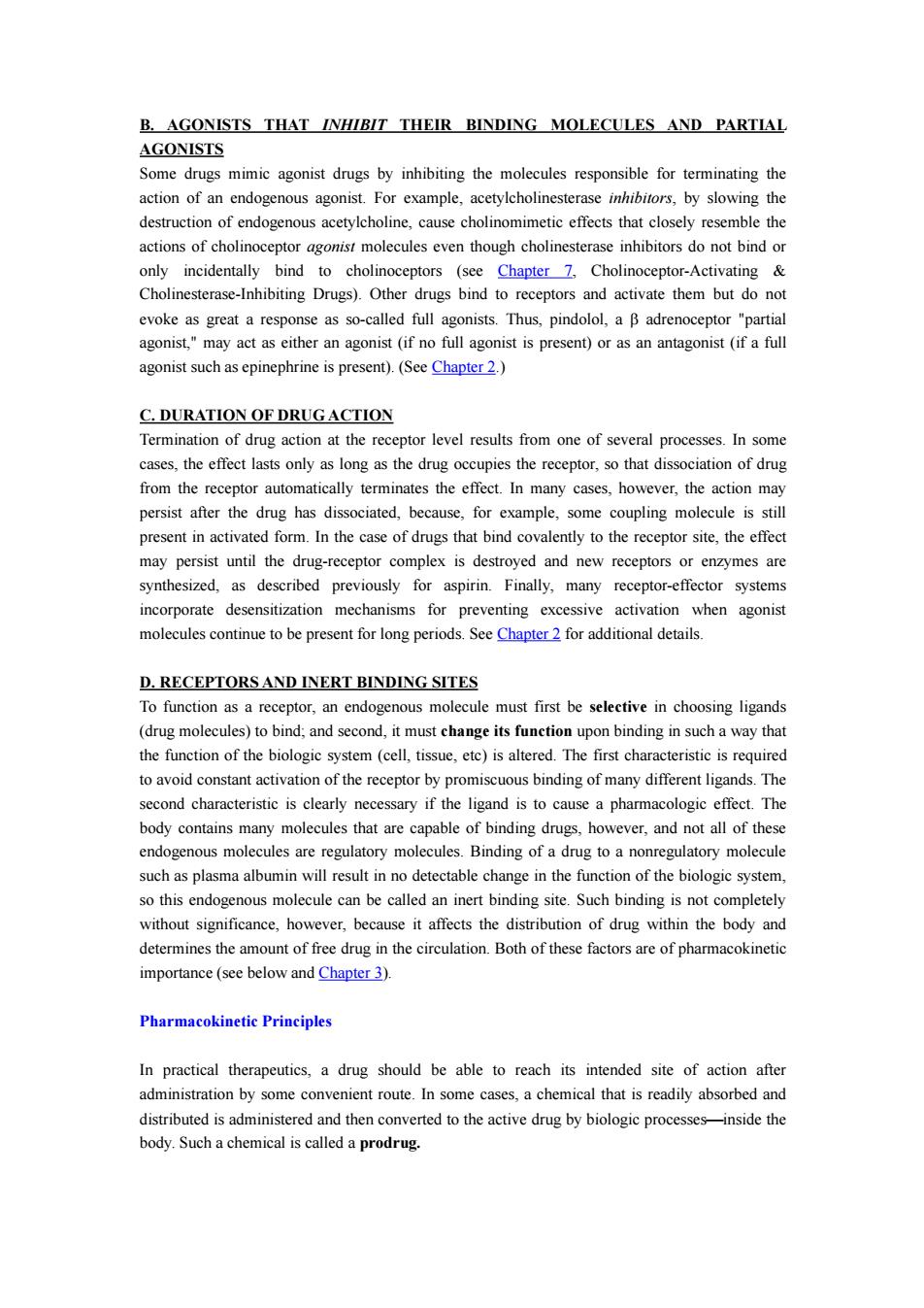正在加载图片...

B.AGONISTS THAT INHIBIT THEIR BINDING MOLECULES AND PARTIAL AGONISTS Some drugs mimic agonist drugs by inhibiting the molecules responsible for terminating the action of an endogenous agonist.For example,acetylcholinesterase inhibitors,by slowing the destruction of endogenous acetylcholine,cause cholinomimetic effects that closely resemble the actions of cholinoceptor agonist molecules even though cholinesterase inhibitors do not bind or only incidentally bind to cholinoceptors (see Chapter 7,Cholinoceptor-Activating Cholinesterase-Inhibiting Drugs).Other drugs bind to receptors and activate them but do not evoke as great a response as so-called full agonists.Thus,pindolol,a B adrenoceptor "partial agonist,"may act as either an agonist(if no full agonist is present)or as an antagonist(if a full agonist such as epinephrine is present).(See Chapter 2.) C.DURATION OF DRUGACTION Termination of drug action at the receptor level results from one of several processes.In some cases,the effect lasts only as long as the drug occupies the receptor,so that dissociation of drug from the receptor automatically terminates the effect.In many cases,however,the action may persist after the drug has dissociated,because,for example,some coupling molecule is still present in activated form.In the case of drugs that bind covalently to the receptor site,the effect may persist until the drug-receptor complex is destroyed and new receptors or enzymes are synthesized,as described previously for aspirin.Finally,many receptor-effector systems incorporate desensitization mechanisms for preventing excessive activation when agonist molecules continue to be present for long periods.See Chapter 2 for additional details. D.RECEPTORS AND INERT BINDING SITES To function as a receptor,an endogenous molecule must first be selective in choosing ligands (drug molecules)to bind:and second,it must change its function upon binding in such a way that the function of the biologic system (cell,tissue,etc)is altered.The first characteristic is required to avoid constant activation of the receptor by promiscuous binding of many different ligands.The second characteristic is clearly necessary if the ligand is to cause a pharmacologic effect.The body contains many molecules that are capable of binding drugs,however,and not all of these endogenous molecules are regulatory molecules.Binding of a drug to a nonregulatory molecule such as plasma albumin will result in no detectable change in the function of the biologic system, so this endogenous molecule can be called an inert binding site.Such binding is not completely without significance,however,because it affects the distribution of drug within the body and determines the amount of free drug in the circulation.Both of these factors are of pharmacokinetic importance(see below and Chapter 3). Pharmacokinetic Principles In practical therapeutics,a drug should be able to reach its intended site of action after administration by some convenient route.In some cases,a chemical that is readily absorbed and distributed is administered and then converted to the active drug by biologic processes-inside the body.Such a chemical is called a prodrug.B. AGONISTS THAT INHIBIT THEIR BINDING MOLECULES AND PARTIAL AGONISTS Some drugs mimic agonist drugs by inhibiting the molecules responsible for terminating the action of an endogenous agonist. For example, acetylcholinesterase inhibitors, by slowing the destruction of endogenous acetylcholine, cause cholinomimetic effects that closely resemble the actions of cholinoceptor agonist molecules even though cholinesterase inhibitors do not bind or only incidentally bind to cholinoceptors (see Chapter 7, Cholinoceptor-Activating Cholinesterase-Inhibiting Drugs). Other drugs bind to receptors and activate them but do not evoke as great a response as so-called full agonists. Thus, pindolol, a adrenoceptor "partial agonist," may act as either an agonist (if no full agonist is present) or as an antagonist (if a full agonist such as epinephrine is present). (See Chapter 2.) C. DURATION OF DRUG ACTION Termination of drug action at the receptor level results from one of several processes. In some cases, the effect lasts only as long as the drug occupies the receptor, so that dissociation of drug from the receptor automatically terminates the effect. In many cases, however, the action may persist after the drug has dissociated, because, for example, some coupling molecule is still present in activated form. In the case of drugs that bind covalently to the receptor site, the effect may persist until the drug-receptor complex is destroyed and new receptors or enzymes are synthesized, as described previously for aspirin. Finally, many receptor-effector systems incorporate desensitization mechanisms for preventing excessive activation when agonist molecules continue to be present for long periods. See Chapter 2 for additional details. D. RECEPTORS AND INERT BINDING SITES To function as a receptor, an endogenous molecule must first be selective in choosing ligands (drug molecules) to bind; and second, it must change its function upon binding in such a way that the function of the biologic system (cell, tissue, etc) is altered. The first characteristic is required to avoid constant activation of the receptor by promiscuous binding of many different ligands. The second characteristic is clearly necessary if the ligand is to cause a pharmacologic effect. The body contains many molecules that are capable of binding drugs, however, and not all of these endogenous molecules are regulatory molecules. Binding of a drug to a nonregulatory molecule such as plasma albumin will result in no detectable change in the function of the biologic system, so this endogenous molecule can be called an inert binding site. Such binding is not completely without significance, however, because it affects the distribution of drug within the body and determines the amount of free drug in the circulation. Both of these factors are of pharmacokinetic importance (see below and Chapter 3). Pharmacokinetic Principles In practical therapeutics, a drug should be able to reach its intended site of action after administration by some convenient route. In some cases, a chemical that is readily absorbed and distributed is administered and then converted to the active drug by biologic processesinside the body. Such a chemical is called a prodrug